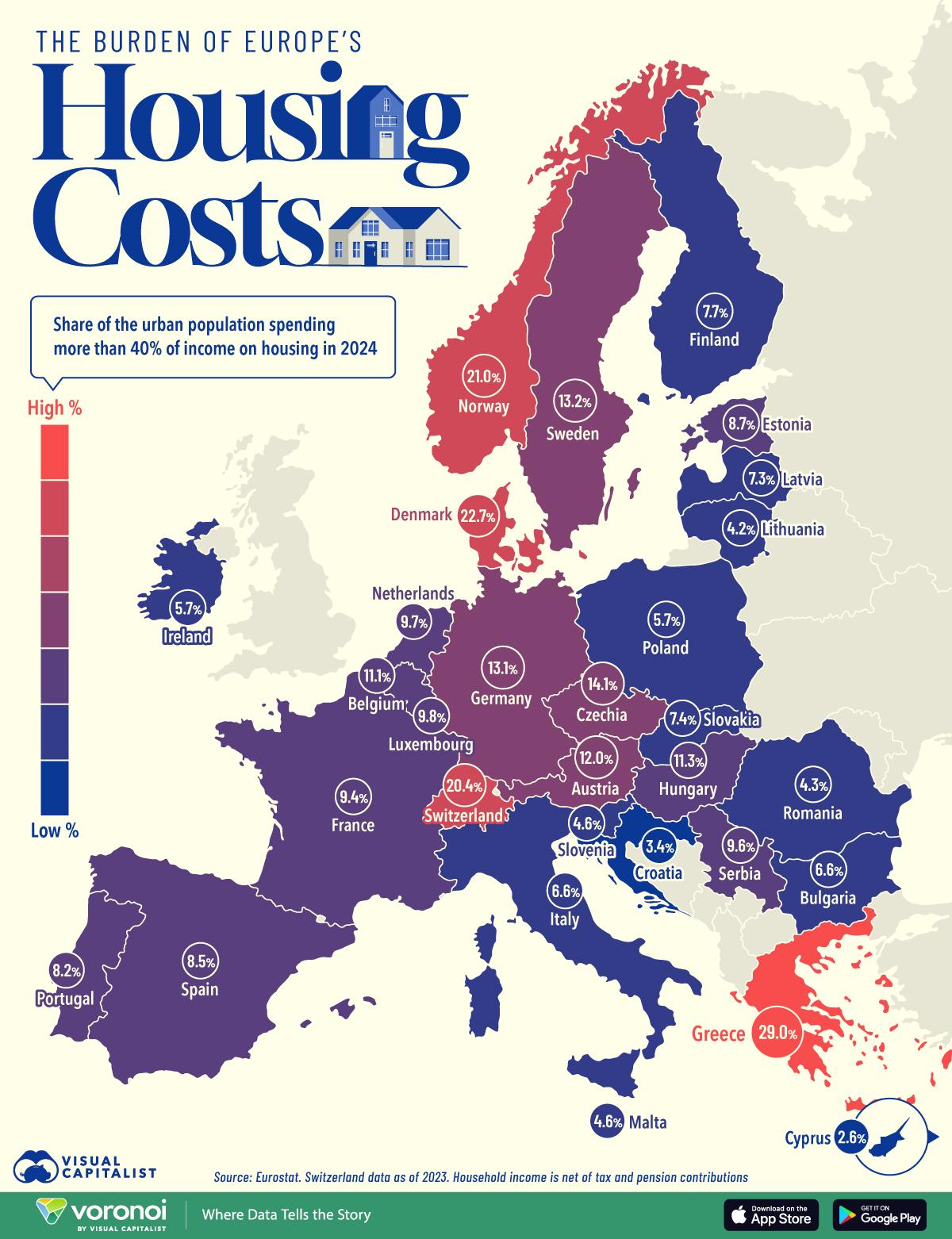Europe’s Housing Cost Burden by Country Map


Marcus Rodriguez
Historical Geography Expert
Marcus Rodriguez specializes in historical cartography and geographic data analysis. With a background in both history and geography, he brings unique...
Geographic Analysis
What This Map Shows
The "Europe’s Housing Cost Burden by Country" map provides a visual representation of how housing costs vary across Europe and the burden they impose on residents. This visualization highlights the percentage of income that households spend on housing, allowing us to assess housing affordability in different nations. As you delve into this map, you'll notice striking disparities in housing costs relative to income, revealing crucial insights into the economic realities faced by residents in various European countries.
Deep Dive into Housing Cost Burden
Housing cost burden typically refers to the proportion of a household’s income that is spent on housing expenses, including rent or mortgage payments. A widely accepted benchmark is that if a household spends more than 30% of its income on housing, it is considered burdened. This metric is vital for understanding economic well-being and social equity in different regions.
Interestingly, Europe presents a complex landscape when it comes to housing costs. For instance, countries like Switzerland and Norway often top the charts in terms of high housing costs relative to income. In these nations, a significant portion of the population may find themselves spending upwards of 40-50% of their income on housing, leading to financial strain and a reduced capacity to invest in other essential needs such as education or healthcare.
Conversely, countries in Eastern Europe, such as Poland and Hungary, often showcase lower housing costs relative to income. However, this does not automatically equate to better living conditions. In many cases, lower housing costs can be symptomatic of broader economic challenges, including lower average incomes and fewer employment opportunities. Thus, while housing may be more affordable, it may not necessarily translate to a higher quality of life.
Data from Eurostat reveals that, as of 2021, approximately 11% of the EU population was considered to be living in households with a housing cost burden. This figure varies significantly across countries; for instance, more than 30% of renters in countries like Spain and Greece face a housing cost burden, largely due to economic stagnation and high unemployment rates.
Additionally, the COVID-19 pandemic has exacerbated these issues, leading to increased housing insecurity in many areas. With rising living costs and stagnant wages, the challenge of housing affordability is more relevant now than ever.
Regional Analysis
Breaking down the housing cost burden by region reveals intriguing patterns. Western Europe, encompassing countries like Germany, France, and the UK, generally experiences high housing costs. In cities such as London and Paris, the cost of housing can consume a significant percentage of household income, often leading to a reliance on government subsidies or shared housing arrangements. The demand for housing in urban centers continues to drive prices up, making it increasingly challenging for lower and middle-income families to secure affordable accommodation.
In contrast, Northern European countries like Finland and Denmark have implemented robust social housing policies that have helped mitigate the housing cost burden for many residents. These countries often have public housing options that are well-maintained and affordable, allowing lower-income households to find suitable housing without excessive financial strain.
Eastern and Southern Europe tell a different story. Nations like Bulgaria and Romania showcase lower housing costs, but high unemployment and lower average incomes mean that the burden still weighs heavily on many households. It’s common to find families living in precarious situations, often in substandard housing, as they struggle to make ends meet.
Interestingly, Mediterranean countries like Italy and Greece, while experiencing a tourism boom, still grapple with high housing costs in popular urban areas, resulting in a dilemma where locals may be priced out of their own neighborhoods due to rising rental costs.
Significance and Impact
Understanding housing cost burdens is crucial for policymakers and urban planners. It directly impacts economic stability, social equity, and quality of life. High housing costs can lead to increased poverty rates, social unrest, and a decline in mental health among residents. Furthermore, as cities grow and populations increase, addressing the housing crisis becomes paramount to ensure that all citizens have access to affordable housing.
Current trends indicate that housing costs are likely to continue rising, particularly in urban centers where demand significantly outstrips supply. As remote work models become more prevalent, previously suburban or rural areas may also experience increased demand, further complicating the housing landscape.
Looking ahead, the integration of sustainable housing practices and the promotion of affordable housing initiatives will be vital in addressing these challenges. Innovative housing solutions, such as co-housing and community land trusts, may offer pathways to alleviate some of the pressures faced by residents in high-cost areas.
In conclusion, the "Europe’s Housing Cost Burden by Country" map serves as more than just a visualization; it highlights a pressing issue that affects millions of people across the continent. By examining and understanding these patterns, we can work toward creating a more equitable housing environment for all Europeans.
Visualization Details
- Published
- September 18, 2025
- Views
- 90
Comments
Loading comments...